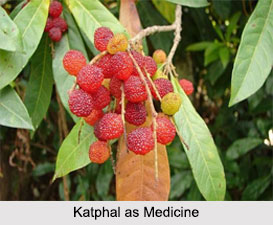 Katphal is a wild fruit of Uttarakhand, too sweet in taste. The bark of Myrica Sapida, i.e. Katphal is its most valuable product and is largely exported to the plains. It is dark or brownish grey, with deep vertical wrinkles, and is considered heating, stimulant and useful in diseases supposed to be caused by deranged phlegm, such as catarrhal fever, cough and affections of the throat.
Katphal is a wild fruit of Uttarakhand, too sweet in taste. The bark of Myrica Sapida, i.e. Katphal is its most valuable product and is largely exported to the plains. It is dark or brownish grey, with deep vertical wrinkles, and is considered heating, stimulant and useful in diseases supposed to be caused by deranged phlegm, such as catarrhal fever, cough and affections of the throat.
Dose of Katphal in Medicine
It enters into the composition of numerous formulae for these diseases. The following is an example.
Katphaladi Churna: Take the bark of Myrica sapida, tubers of Cyperus rotundus (mustaka), root of Picrorrhiza Kurroa (katuki), Curcuma Zedoaria (sati), Rhus succedanea (Karkata Sringi), and the root of Aplotaxis auriculata (kushta) in equal parts and mix to form a powder. This powder is given in doses of about a drachm with the addition of ginger-juice and honey in affections of the throat, cough and asthma. In catarrh with headache the powdered bark is occasionally used as a snuff.
This article is a stub. You can enrich by adding more information to it. Send your Write Up to content@indianetzone.com
Related Articles
Ayurveda
Sushruta Samhita
Classification of Medicine
Properties of Material Objects and its Effect on Human Body
Indian Herbs
Traditional Indian Medicines




















